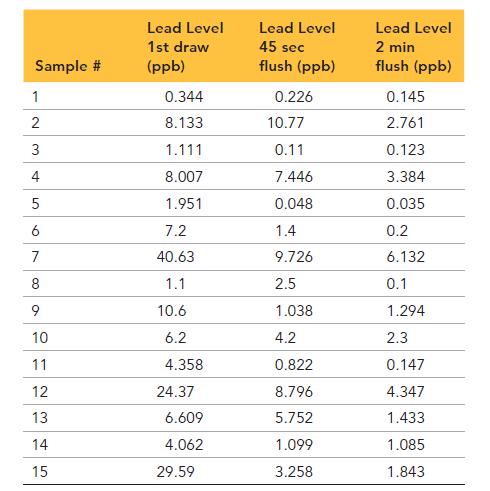In April of 2014, in an effort to save money, officials in Flint, Michigan, changed their water
Question:
In April of 2014, in an effort to save money, officials in Flint, Michigan, changed their water source from Lake Huron to the Flint River. In subsequent months, residents began complaining about the quality of the water, and General Motors stopped using the water in manufacturing processes because of its corrosiveness.
That corrosiveness was causing problems that would soon fuel a national outrage. The water flowed through pipes to taps in homes, and as it flowed through the pipes—many of which contained lead—the corrosive water became contaminated with lead.
Routine monitoring of the tap water in select homes did not reveal the magnitude of the problem because samples were collected only after preflushing the tap (allowing the water to run for a time). A Virginia Tech professor and his students began an independent test of the water coming from Flint’s taps and got much different results by analyzing the water that initially came from the taps (called 1st draw). Their results—which showed elevated lead levels in the tap water—ultimately forced officials to switch back to the Lake Huron water source.
The table below shows a set of data collected by the Virginia Tech team. The lead levels in water are expressed in units of part per billion (ppb). 1 ppb = 1 g Pb/109 parts solution. Examine the data and answer the questions that follow.
a. Determine the average value of lead for 1st draw, 45-second flush, and 2-minute flush (round to three significant figures).
b. Does the data support the idea that running the tap water before taking a sample made the lead levels in the water appear lower? Why might this occur?
c. The EPA requires water providers to monitor drinking water at customer taps. If lead concentrations exceed 15 ppb in 10% or more of the taps sampled, the water provider must notify the customer and take steps to control the corrosiveness of the water. If the water provider in Flint had used 1st-draw samples to monitor lead levels, would they have been required to take action by EPA requirements? If the Flint water provider used 2-min flush samples, would they have had to take action? Which drawing technique do you think more closely mimics the way residents actually use their water?
d. Using the highest value of lead from the 1st-draw data set, and assuming a resident drinks 2 L of water per day, calculate the mass of lead that the resident would consume over the course of 1 year. (Assume the water has a density of 1.0 g/mL.)
Step by Step Answer:






